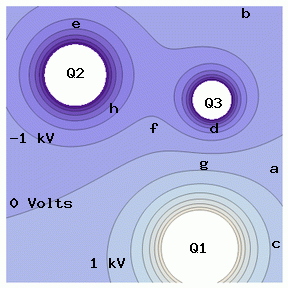TRUE OR FALSE- I WILL GIVE QUICK RATING! The lines in the figure below show the equipotential contours in the plane of three point charges, Q1, Q2, and Q3. Note that these are point charges (one is not bigger in size than the others; they're points). That means that the potential goes to infinity as you approach them. We've cut off the contours at plus and minus 7kV. The white space is where the potential is greater or less than that. The values of the equipotential lines are in kV, and we labeled the +1, 0, and -1 kV contours. The positions of the charges are also labeled.
a)Charge Q3 is the largest negative charge.
b)The electric field E at 'a' is stronger than at 'g'.
c)Charge Q1 has the smallest magnitude of all.
d)Q2 is a negative charge.
e)The force on an electron at 'd' points toward Q1.
f)The magnitude of the electric field E at 'f' is nonzero.

Trending nowThis is a popular solution!
Step by stepSolved in 8 steps with 1 images

- Prob.2. Three charges (Q1 = Q3 = 20.0nC, and Q2 = - 10.0nC) are arranged on the three %3D vertices of a triangle as shown. [a]Determine the electric potential energy (in units of UJ) of the three-charge configuration. (Example: If your answer is 4.5x10-6J = 4.5µJ, enter your answer as 4.5) 4.0cm 3.0cm- 3.0cmarrow_forwardPart B: Rectangle Three point charges (the charge for each is shown in terms of Q) are arranged at the corners of a rectangle as shown in the figure below. What is the potential at the fourth corner (point P)? Express your answer in terms of k, Q, & L. Ф= -70 2L 20 5L -9Qarrow_forward13Yash) Please need the correct to this problem with full explanation and methods how you get the answer, please.arrow_forward
- The lines in the figure below show the equipotential contours in the plane of three point charges, Q1, Q2, and Q3. Note that these are point charges (one is not bigger in size than the others; they're points). That means that the potential goes to infinity as you approach them. We stop showing countours past plus and minus 7kV. The white space is where the potential is greater or less than that. The values of the equipotential lines are in kV, and we labeled the +1, 0, and -1 kV contours. The positions of the charges are also labeled. For the following, check each box that corresponds to a true statement. Select "None of the above" if none of them are true.A. The electric field at point e is stronger than the field at point c.B. Charge Q3 has the smallest magnitude of all.C. The force on a proton at point c would point towards charge Q3.D. Charge Q1 is a positive charge.E. Charge Q2 is the smallest negative charge.F. The magnitude of the electric field at point f is zero.G. None of the…arrow_forwarda parallel plate capacitor creates an electric field of strength 10N/C between its plates, which are separated by 10mm. If a small sphere with charge 2 nC and mass of 20 g is held next to the positive plate, what is the force on that sphere? What will the acceleration of the sphere be? how long will it take to reach the other plate? What will its speed be when it reaches the other plate?arrow_forward